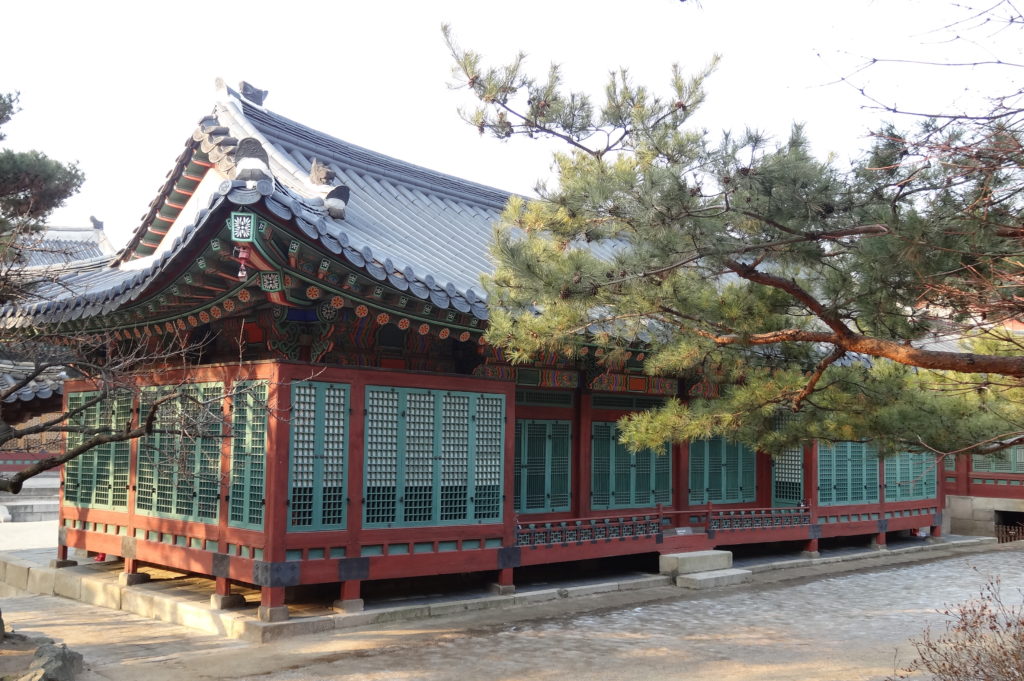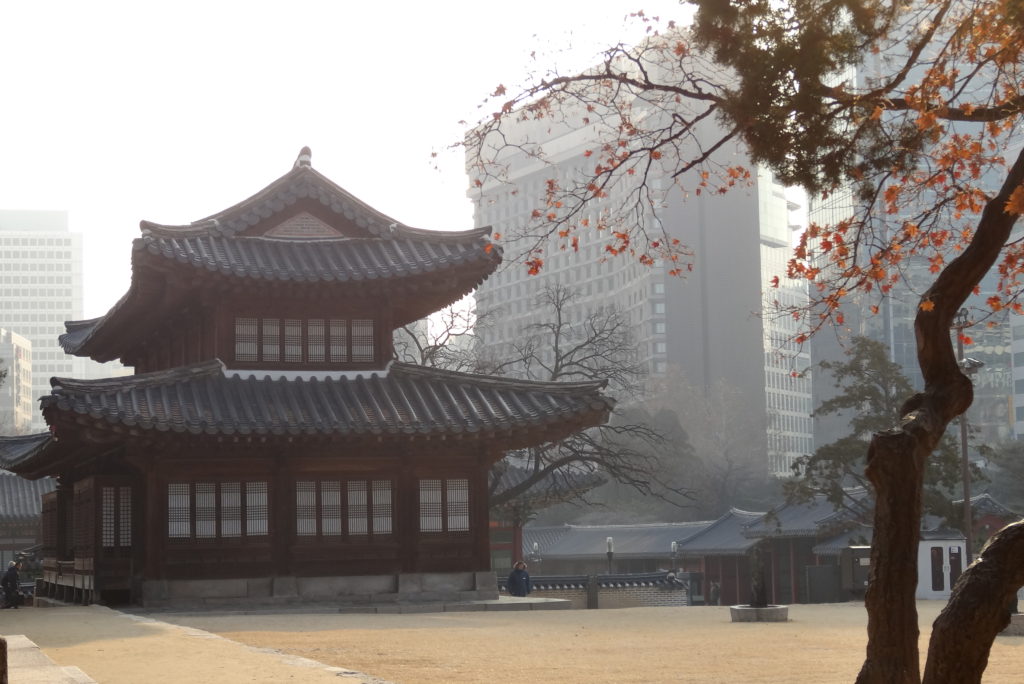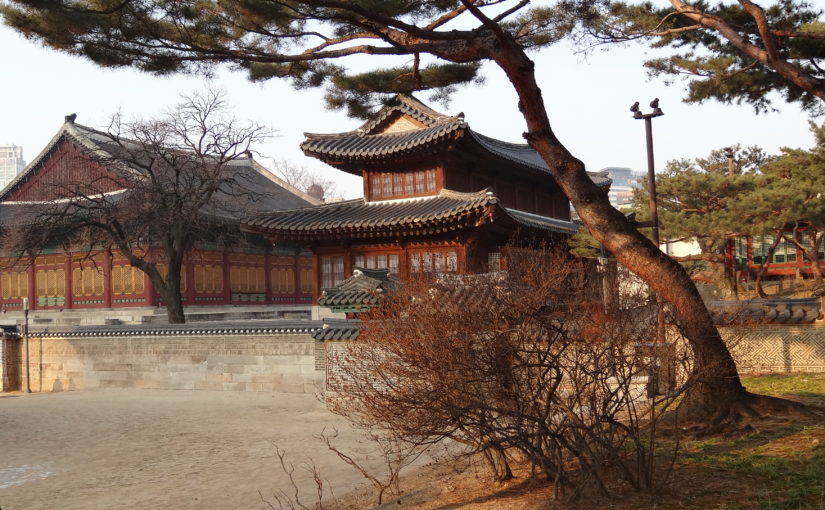Travel period Feb 2017
The “Palace of Virtuous Longevity”
Deoksugung Palace is famous for its elegant stone-wall road. Only ten minutes’ walk from our hotel. Located at the corner of the busiest intersection of downtown Seoul near City hall, it was the only Palace that has western buildings beside it, and this adds to the uniqueness of the scenery.
The Palace
Deoksugung Palace was the location where Prince Wolsan, older brother of King Seongjong, lived. At the time, the residence was not yet known as a palace. The area consisted of residential buildings for descendants of the royal family. This was the last of Seoul’s Famous Five palaces to be built, and it became the country’s seat of power almost by default, when the Japanese destroyed Gyeongbokgung in 1592.
Not quite as splendid as the other palaces, Deoksugung is overlooked by the tall grey towers of the City Hall business and embassy area, and includes a couple of Western-style buildings. The palace dates back to when the “Hermit Kingdom” in the latter part of the Joseon dynasty was being forcibly opened up to trade. These neoclassical structures remain the most notable on the complex.
We started our tour from the main gate, named Daehanmun Gate.

Daehanmun Gate is the main gate of Deoksugung Palace. Located in the east, it became the main entrance of the palace after the completion of Wongudan Altar (Hwangudan Altar). The original main gate was Inhwamun. In 1970 it was moved to the west because of the nearby expansion of Taepyeong-no Street.

Deokhongjeon Hall is where King Gojong met with high ranking and foreign envoys and other officials. Construction on the building was completed in 1911. The hall is one of the newest structures at the palace.

Geumcheongyo Bridge is located just past Daehanmun Gate on the grounds of Deoksugung. The bridge was built in 1411 and is the oldest surviving in Seoul. The bridge was excavated and restored in 1986. Those who enter through the main gate cross over a stream. This is a common sight at palaces in Seoul. Crossing the stream symbolizes purifying oneself before entering.

Gwangmyeongmun Gate was once the south gate at Deoksugung Palace. It contains a water clock, a hanging bronze bell from 1462, and a rocket cannon. The gate, which resembles a pavilion, once led to Hamnyeongjeon Hall, where the king resided. The water clock, which has automatic striking, is known as Jagyeokru. The bell, forged in 1462 during the Joseon Dynasty, is from Heungcheonsa Temple. The cannon, which can be wheeled, uses gunpowder and can fire 100 arrows at the same time.

Hamnyeongjeon Hall was the sleeping residence of King Gojong when he moved from the Russian Legation back to Deoksugung Palace (Gyeongugung) in 1897. Gojong also died at this location in 1919 at the age of 66. In 1904, the hall was destroyed by fire. It was rebuilt that same year. After Gojong died, Hamnyeongjeon Hall was used as his spirit hall and is the location of his coffin and memorial tablet.
The hall was designed with an ondol, which is a heating system that is found under the wooden floor. This is a common feature in the sleeping quarters of royal palaces. Servants would stay just outside the rooms. Behind the building is a terraced garden with decorated chimneys.

Located on the hill at the rear garden is Jeonggwanheon Pavilion. The pavilion was used for banquets for foreign visitors when they visited the palace. The building was constructed around 1900 by A.I. Sabatin, a Russian architect. He was influenced both by Korean and Western designs.
The design features Romanesque style colonnades that surround the perimeter of the building. The columns are made of imitation stone.
Verandas can be found on three sides of the building, on the west, east, and south. Wooden columns on the verandas are decorated with dragons, bats, and vases. These decorations are quite common Korean motifs.

Jeukjodang Hall is where King Gwanghaegun (1608) and King Injo (1623) were crowned kings. Its name means “house where kings ascended their throne”. Gwanghaegun reigned from 1608 to 1623 while Injo reigned from 1623 to 1649. The original structure, along with Junmyeongdang, was destroyed by fire in 1904. They were both rebuilt later that same year.

Junghwajeon Hall is the main throne hall at Deoksugung Palace. Jeukjodang Hall originally served as the throne hall until Junghwajeon was built to the south. When the hall was built in 1902 it featured a two-tiered roof. In 1904, it was damaged by fire, however it was rebuilt two years later with a single level roof as seen today.

Junghwamun Gate is the inner gate of Deoksugung and the main gate of Junghwajeon Hall. The gate, along with Junghwajeon, were rebuilt in 1906 after being destroyed by fire making it one of the last structures built during the Joseon Dynasty.

Junmyeongdang Hall was where King Gojong handled palace and state affairs during his reign. He also welcomed honored guests and foreign officials here. The original structure, along with Jeukjodang, was destroyed by fire in 1904. The hall was rebuilt later that same year.

Seogeodang Hall is an ordinary and plain two-story wooden house where King Seonjo lived and died. He was the 14th Joseon king and ruled from 1567 to 1608. The design is ordinary without decorations or paint, which is similar to houses at the time.

Seokjojeon Hall, built in 1910, is a Western style building used as an audience hall and sleeping quarters of King Gojong and later as an art museum. The architectural style is 19th century neoclassical, with ionic style colonnades, and a triangular roof. This is very unique to Korea and interesting compared to other buildings at Deoksugung.
We hope you enjoyed seeing our visit to Deoksugung Palace! We certainly did. It was great and definitely worth checking out if you have some free time in your schedule and are around the City Hall area.
Directions to Deoksugung Palace
Take Subway Line 1 to City Hall Station (Exit 2). OR
Take Subway Line 2 to City Hall Station (Exit 12).
Hours
9:00-21:00 (Ticket office close 1 hour before closing time).
Guided Tours in English are at 10:30, 13:40 on Saturdays (odd numbered months), 13:40 on Sundays (even numbered months).
Closed on Monday
Fees
Adult: KRW 1,000
Child: KRW 500
This Palace is included with the Integrated Ticket of Palaces.
Note: The information provided in this post was correct at time of publishing but may change. For final clarification please check with the relevant service.

